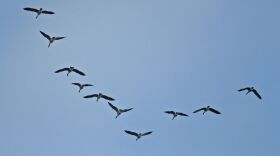Organisms change over time in response to the environment around them.
In this episode of Wildlife Matters, the Masked Biologist examines adaptations and evolution.
I have had a few discussions recently about evolutionary changes in living organisms. In the course of my writings, adaptations and evolution are recurring themes. Think about the amazing diversity of wildlife, fish, birds, and plants. Every time I choose a subject to write about, no matter how mundane it may seem at the outset, I always find something new and interesting that causes me to marvel at how we have arrived at this point. None of what we see in living organisms today would be possible without adaptations and evolution.
For the purposes of this discussion, it is important to be familiar with the difference between adaptations and evolution. Adaptation occurs when an individual makes an adjustment within their own lifetime in response to something in their environment in order to maintain their life activities. For example, say a black bear breaks its front leg. The break is severe, causing the bone to protrude from the skin. The tissue damage is extensive, and the leg begins to die. There is a good chance that the bear will die—maybe from blood loss, or infection, or maybe starvation or thirst because it cannot tend itself. Another possibility is that the leg dies, but the bear is able to survive and ends up with three legs. The bear must adapt to being three-legged; it has to fight of aggressors, find food, even try to breed while moving about on three legs. This does happen; I get one or two reports of three-legged deer or bears a year. These animals have developed behavioral adaptations. Or, a more simplistic example would be a look at your skin. Right now, unless you are a recently returned snowbird, your skin is probably very pale. However, if you examine your skin in two months, it may be significantly darker in appearance because melatonin has darkened it. What about the plants that bend to grow toward sunlight? Because of CAM 3 pathways, the darker side of the plant grows faster than the lighter side of the plant, so the plant can physically change to get the life-giving light it needs. Structural, behavioral and physiological adaptations are key to the survival of an individual.
Evolution, on the other hand, is a kind of adaptation that occurs across generations within the same species. It doesn’t have to be millions of years; some animals can have more than one generation in a year. I have seen some adaptations that caused animals to evolve. For example, I believe that deer are evolving to look both ways before crossing the street. When I was young, it was common to see deer step out on the road and look at your vehicle. I don’t remember seeing them look both ways before cautiously stepping out. Now, however, it has become increasingly common for me to see adult does look for cars before stepping on the pavement. Think about it. say you have two does, each with a fawn. The first doe runs into the street without looking, and suddenly the fawn is an orphan. The likelihood of that fawn surviving to adulthood is now drastically reduced. The second doe takes a little more time to look for cars, and consequently she and her fawn safely cross the road. For the next six months or more, the fawn learns safety from her mother, and when she leaves her mother’s side and bears a fawn of her own, she looks both ways as she has learned and she and her fawn survive. It is not hard to imagine over a few years that the deer that survive to reproduce have applied that behavior, looking both ways before crossing the street, as a mechanism we know as survival of the fittest.
Adaptation and evolution are occurring around us every day. A tree growing out of a rock? Adaptation. Wood frogs freezing almost completely solid as a mechanism to survive winter? Evolution. Learning to understand and appreciate these mechanisms can help us all understand the relationships between predator and prey, plant and animal, or planet and man.
Striving to make new things familiar and familiar things new, this is the Masked Biologist coming to you from the heart of Wisconsin’s great Northwoods.







